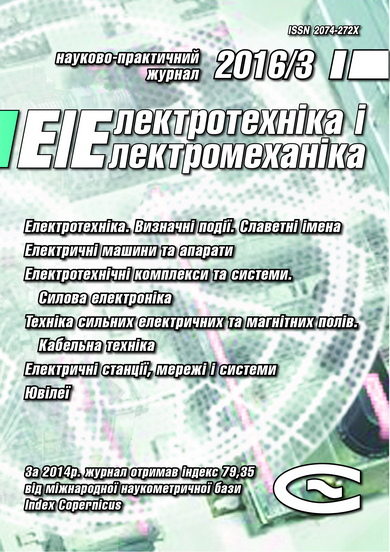ORTHOGONAL COMPONENTS OF THE THREE-PHASE CURRENT AT ASYMMETRICAL ACTIVE - REACTIVE LOAD IN 4-WIRE CIRCUIT
DOI:
https://doi.org/10.20998/2074-272X.2016.3.10Keywords:
three-phase circuit, active and reactive power, power shift, power equation, unbalanced current and mode, active-reactive asymmetrical load, asymmetrical voltage, currents' physical components (CPC)Abstract
Purpose. For the unbalanced sinusoidal mode with asymmetric voltage in 3-phase 4-wire circuits to receive the orthogonal 4-component decomposition of 3-phase current, are classified symmetry/asymmetry of active and reactive load elements separately. Methodology. The methodology is based on the vector approach, which with one voice allows to analyze the energy characteristics of a 4-wire and 3-wire circuits as balanced and unbalanced modes. At asymmetrical voltage the matrix representation methodology of the equivalent conductivities is used. Results. For 3-phase 4-wire network with a sinusoidal unbalanced mode with asymmetric voltage obtained 4-component orthogonal decomposition of the 3-phase current. The components have a clear electro-energetic sense and are classified irrespective by the load condition. Originality. The resulting decomposition current develops the theory Currents' Physical Components (CPC) for 4-wire circuit with asymmetric voltage. For the first time the unbalanced current is classified by activity and reactivity of asymmetry load elements. Practical value. Practical value of the obtained orthogonal decomposition current and the power equation is a possibility of their utilization for the increase both quality of delivery and quality of consumption of electrical energy.References
1. 1459-2010 IEEE Standard definitions for the measurement of electric power quantities under sinusoidal, nonsinusoidal, balanced, or unbalanced conditions. doi: 10.1109/ieeestd.2010.5439063.
2. Czarnecki L.S. Orthogonal decomposition of the currents in a 3-phase nonlinear asymmetrical circuit with a nonsinusoidal voltage source. IEEE Transactions on Instrumentation and Measurement, 1988, vol.37, no.1, pp. 30-34. doi: 10.1109/19.2658.
3. Ferrero A., Superti-Furga G. A new approach to the definition of power components in three-phase systems under nonsinusoidal conditions. IEEE Transactions on Instrumentation and Measurement, 1991, vol.40, no.3, pp. 568-577. doi: 10.1109/19.87021.
4. Lev-Ari H., Stankovic A.M. A decomposition of apparent power in polyphase unbalanced networks in nonsinusoidal operation. IEEE Transactions on Power Systems, 2006, vol.21, no.1, pp. 438-440. doi: 10.1109/tpwrs.2005.860903.
5. Czarnecki L.S., Haley P.M. Unbalanced power in four-wire systems and its reactive compensation. IEEE Transactions on Power Delivery, 2015, vol.30, no.1, pp. 53-63. doi: 10.1109/tpwrd.2014.2314599.
6. Czarnecki L.S., Bhattarai P.D. Currents' physical components (CPC) in three-phase systems with asymmetrical voltage. Przegląd Elektrotechniczny, 2015, no.6, pp. 40-47. doi: 10.15199/48.2015.06.06.
7. Sirotin Iu.А. Vectorial instantaneous power and energy modes in three-phase circuits. Tekhnichna elektrodynamika – Technical electrodynamics, 2013, no.6, pp. 57-65. (Rus).
8. Sirotin Iu.A. Non-pulsed mode of supply in a three-phase system at asymmetrical voltage. Przeglad Elektrotechniczny, 2013, no.7, pp. 54-58.
Downloads
Published
How to Cite
Issue
Section
License
Copyright (c) 2016 Iu. A. Sirotin

This work is licensed under a Creative Commons Attribution-NonCommercial 4.0 International License.
Authors who publish with this journal agree to the following terms:
1. Authors retain copyright and grant the journal right of first publication with the work simultaneously licensed under a Creative Commons Attribution License that allows others to share the work with an acknowledgement of the work's authorship and initial publication in this journal.
2. Authors are able to enter into separate, additional contractual arrangements for the non-exclusive distribution of the journal's published version of the work (e.g., post it to an institutional repository or publish it in a book), with an acknowledgement of its initial publication in this journal.
3. Authors are permitted and encouraged to post their work online (e.g., in institutional repositories or on their website) prior to and during the submission process, as it can lead to productive exchanges, as well as earlier and greater citation of published work.





